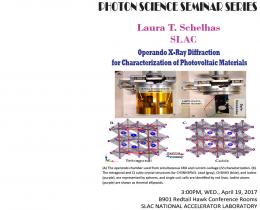Speaker: Laura T. Schelhas, SLAC
Program Description
Hybrid organic-inorganic perovskite photovoltaic (HOIPVs) materials have been the focus of much research in recent years due in part to their extremely high photoconversion efficiencies1 and also their ability to be synthesized by solution processing. These materials crystallize in the perovskite, AMX3 crystal structure where A is the monovalent cation (methyl ammonium, MA, formamidinium, FA, Rb, and/or Cs), M is the metal cation (Pb2+), and X is the halide anion (I−, Cl−, and/or Br−). As the field has progressed, formulations of HOIPVs have evolved from the simple MAPbI3 to more complex alloys, e.g. RbCsMAFA-perovskite.2 With these more complicated formulations understanding the operation and stability of these materials becomes more challenging. For example, it is important to understand the geometric constraints and so-called “tolerance factors” when formulating new alloys in order to target stable structures.3 Additionally, the composition and phase homogeneity across the film can also influence device performance.
In this study we present results using operando X-ray characterization techniques developed by our groups coupled with standard laboratory device measurements.4 Here we describe a methodology for X-ray diffraction of operational solar cell devices. In this work, we present data investigating the structural tetragonal-to-cubic phase transition in CH3NH3PbI3, organic-inorganic perovskite solar cell devices during heating and operation. We hypothesize that the average structure measured by XRD does not dominate the device performance in these devices; rather it is controlled by local ordering, which does not change significantly through the phase transition.
Additionally, we explore the phase stability of HOIPV alloys of the form XPbI3 where X = FA, Cs, and/or MA. Simultaneous JV and XRD measurements on devices are measured in both inert and humid (~50% relative humidity) conditions, at room temperature for up to 15 hours. Here we observe degradation pathways for these alloys which result in phase segregated films in some alloy formulations and greater stability in others. We will comment on potential mechanisms for these differences in stability. With greater understanding of the structural stability of these alloys we aim to inform well-tuned alloy formulations targeting long term stability in devices.





